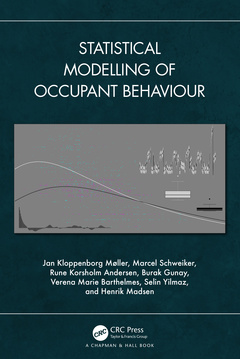Statistical Modelling of Occupant Behaviour
Auteurs : Møller Jan Kloppenborg, Schweiker Marcel, Andersen Rune Korsholm, Gunay Burak, Yilmaz Selin, Barthelmes Verena Marie, Madsen Henrik

Do you have data on occupant behaviour, indoor environment or energy use in buildings? Are you interested in statistical analysis and modelling? Do you have a specific (research) question and dataset and would like to know how to answer the question with the data available?
Statistical Modelling of Occupant Behaviour covers a range of statistical methods and models used for modelling energy- and comfort-related occupant behaviour in buildings. It is a classical textbook on statistics, including many practical examples related to occupant behaviour that are either taken from real research problems or adapted from such.
The main focus is traditional statistical techniques based on the likelihood principle that can be applied to occupant behaviour modelling, including:
- General, generalised linear and survival models
- Mixed effect and hierarchical models
- Linear time series and Markov models
- Linear state space and hidden Markov models
- Illustration of all methods using occupant behaviour examples implemented in R
The built environment affects occupants who live and work in it, and occupants affect the built environment by adapting it to their needs ? for example, by adapting their indoor environments by interacting with building components and systems. These adaptive behaviours account for great uncertainty in the prediction of building energy use and indoor environmental conditions. Occupant behaviour is complex and multi-disciplinary but can be successfully modelled using statistical approaches.
Statistical Modelling of Occupant Behaviour is written for researchers and advanced practitioners who work with real-world applications and modelling of occupant data. It describes the kinds of statistical models that may be used in various occupant behaviour modelling research. It gives a theoretical overview of these methods and then applies them to the study of occupant behaviour using readily replaceable examples in the R environment that are based on actual and experimental data.
1. Introduction. 2. Likelihood. 3. General linear models. 4. Generalized linear models. 5. Linear mixed effects. Models. 6. Hierarchical models. 7. Survival Analysis. 8. Linear Time Series Models. 9. Markov chain models. 10. State Space Models. 11. Hidden Markov Models.
Jan Kloppenborg Møller, PhD, Engineering, is an associate professor in stochastic dynamical systems at the technical university of Denmark (DTU). He received a master of applied mathematics from DTU (2006), and a PhD in engineering from DTU (2011). His research is concentrated on modelling and forecasting of (continuous or discrete time) stochastic dynamical systems. He has been involved in projects and worked on many different systems such as: ecosystems, urban draniage, waste water treatment, wind and solar power forecast, and occupancy behavior. In all cases, focus has been on models that have a clear interpretation of states and parameters.
Møller has taught six different courses in statistics on levels ranging from bachelor to PhD-level. This includes a redesign of the introductory statistics courses at DTU, and the redesign of a second level course in statistics. His research concentrates on stochastic dynamical systems, using the appropriate tools and pushing advanced methods (like stochastic differential equation) towards application areas such as: wind power forecast, electricity load, and occupant behavior.
Marcel Schweiker is a full professor leading the Teaching and Research Area Healthy Living Spaces at the Institute for Occupational, Social and Environmental Medicine at University Hospital RWTH Aachen in Germany. He received a degree in Architecture from the University of Kassel in Germany, and spent four years at Tokyo City University in Japan, where he received a PhD in Environmental and Information Sciences in 2010. Until 2020, he was a researcher and lecturer at the Department of Architecture at the Karlsruhe Institute of Technology in Germany, and received from there, the postdoctoral lecture qualification (habilitation) in 2017. In parallel, between 2019 and 2020, he had a temporary professorship for Energy and Technology at the Faculty of Architecture, TU Kaiserslautern in Germany.
Schweiker’s research and tea
Date de parution : 01-2024
17.8x25.4 cm
Thèmes de Statistical Modelling of Occupant Behaviour :
Mots-clés :
linear models; GLMs; state space models; mixed effects; hidden Markov model; energy; hierarchical models



